Development teams plan to ship features, but often end up juggling priorities. Unplanned work, shifting deadlines, and hidden blockers lead to context switching that slows everyone down. Progress stalls not from a lack of effort, but from a lack of focus and a clear view of the entire workflow.
The Kanban methodology offers a practical way to manage this chaos. Instead of pushing more work onto a busy team, it creates a system where work is pulled forward only when there is capacity. This simple shift from pushing to pulling helps teams focus on finishing work, spot bottlenecks instantly, and adapt to change without derailing progress.
This guide serves as your comprehensive resource for building and leveraging a Kanban system. You’ll learn in detail its core components, guiding principles, and essential practices, providing a clear path to implementation and demonstrating how modern platforms can deliver the visibility and control needed to accelerate product delivery.
Key takeaways
- Start where you are: build your Kanban board around your current workflow and refine it through small, continuous improvements.
- Prevent overload: set work in progress limits to keep focus on finishing tasks and uncover bottlenecks early.
- See everything at a glance: use visual boards so your team can track priorities, progress, and blockers without status meetings.
- Work with real capacity: rely on flow metrics like cycle time and throughput to guide planning and make predictable delivery commitments.
- Power your process with monday dev: automate card updates, track performance, and connect development work directly to Git activity for a more reliable Kanban system.

What is Kanban methodology?
Kanban methodology is a visual system for managing work as it moves through a process. The core of Kanban is the visual board, which allows teams to see all work in progress, restrict the number of items being juggled, and continuously optimize the flow of work from start to finish.
The word ‘Kanban’ means ‘visual signal’ or ‘signboard’ in Japanese. Toyota created this approach in its postwar manufacturing plants to prioritize “just in time” delivery and manage inventory, but today it helps teams manage everything from software development to marketing campaigns.
How does the Kanban system work?
The Kanban system operates on a simple principle: work moves forward only when there’s space for it. Instead of pushing work onto busy team members, people pull new work only when they finish what they’re doing.
Picture a board with columns like ‘To Do,’ ‘In Progress,’ and ‘Done.’ Each piece of work lives on a card that moves from left to right as it progresses. When someone finishes their current work, they pull the next card from the previous column.
This pull system prevents overload and keeps Kanban flow smooth. You can see exactly where everything stands, spot bottlenecks instantly, and make decisions based on real capacity rather than wishful thinking.
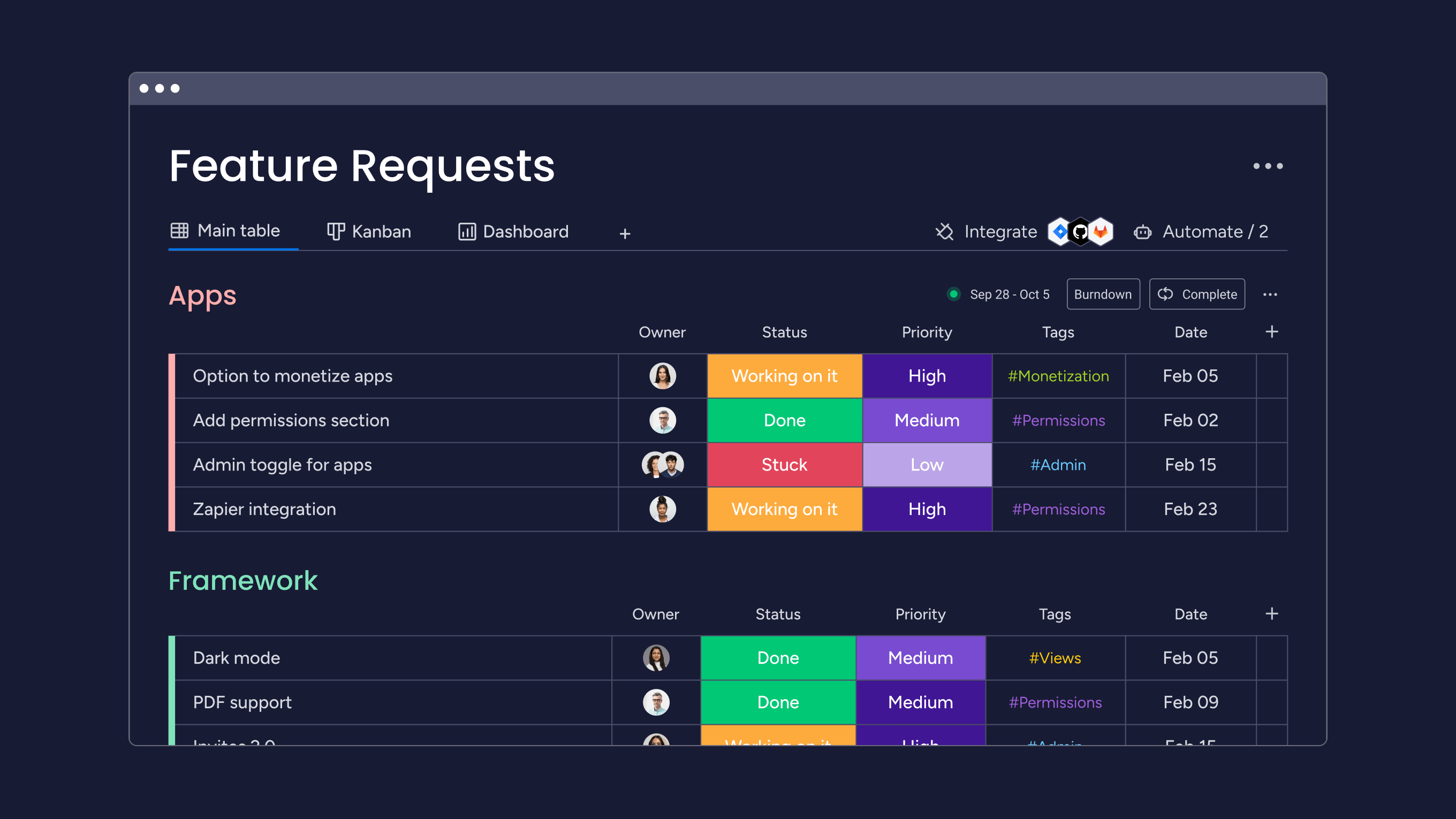
Core components of Kanban
The kanban method works because it breaks complex work into simple, visible parts. Before you build your first board, it helps to understand the core components that keep a kanban system running smoothly.
Kanban boards
A Kanban board is the core visual workspace. It shows all your current work and the exact status of each item in the workflow. While most boards begin with basic stages, such as ‘To Do,’ ‘In Progress,’ and ‘Done’, it is essential that the board be customized to reflect your team’s actual, real-world process.
Modern digital boards provide the flexibility to add custom columns, color coding, and automated workflows. You might add specific stages like ‘Review’ or ‘Testing.’ The key principle remains: the board must mirror reality, not some idealized version of how work should flow.
In the ‘Kanban cards’ subsection
Each piece of work is represented by its own Kanban card. These cards are the single source of truth for the task and are essential for tracking progress:
- Contain key data: every card includes everything needed to complete the work, such as descriptions, deadlines, assigned team members, and relevant files.
- Track progress: as work moves through the process, the card physically progresses across the board (from left to right).
- Centralize context: in modern, flexible platforms like monday dev, cards link directly to conversations, code, and sub-items, centralizing all project context.
Work in progress (WIP) limits
WIP limits how many items can be in each column at once.This constraint ensures the team commits to finishing work before taking on new tasks. By limiting what can be started, WIP limits force a critical shift in focus away from continuous starting and toward reliable completion.
These limits force focus. Instead of starting everything and finishing nothing, teams complete work before taking on more. When you hit a limit, the team rallies to clear the bottleneck rather than just piling on more work.
The 4 core principles of Kanban
Kanban is built on a few guiding principles that keep the framework flexible and easy to adopt. These principles shape how teams visualize work, make improvements, and build a healthier flow over time.
1. Start with what you do now
Kanban doesn’t force you to throw away your current process. You map your existing workflow onto a board and improve from there. No new roles, no mandatory meetings, no disruption to ongoing work.
This gentle start makes adoption easier. Your team keeps working while gradually improving how they work. Modern solutions like monday dev support this approach with flexible boards that adapt to any workflow, letting you start simple and evolve over time.
2. Agree to pursue incremental change
Big changes often fail, therefore, Kanban focuses on small, continuous improvements that stick. You might adjust one WIP limit this week, streamline a handoff next week, and gradually transform how your team delivers value.
These small changes add up. Teams that commit to regular, minor improvements often see dramatic results over months without the disruption of major process overhauls.
3. Respect current processes and roles
Your existing structure stays intact with Kanban. Product managers keep managing products, developers keep developing, and managers keep managing. The methodology works within your current organization rather than demanding reorganization.
This respect for existing structures makes Kanban particularly attractive to established teams. You can improve flow and delivery without threatening anyone’s position or authority.
4. Encourage leadership at all levels
Everyone becomes a leader in Kanban. When you spot a bottleneck, you help fix it. When you see a way to improve flow, you suggest it. Leadership means taking responsibility for the system’s health, not managing people.
This distributed leadership creates resilient teams. Problems get solved faster when everyone feels empowered to act rather than waiting for someone else to notice and fix issues.
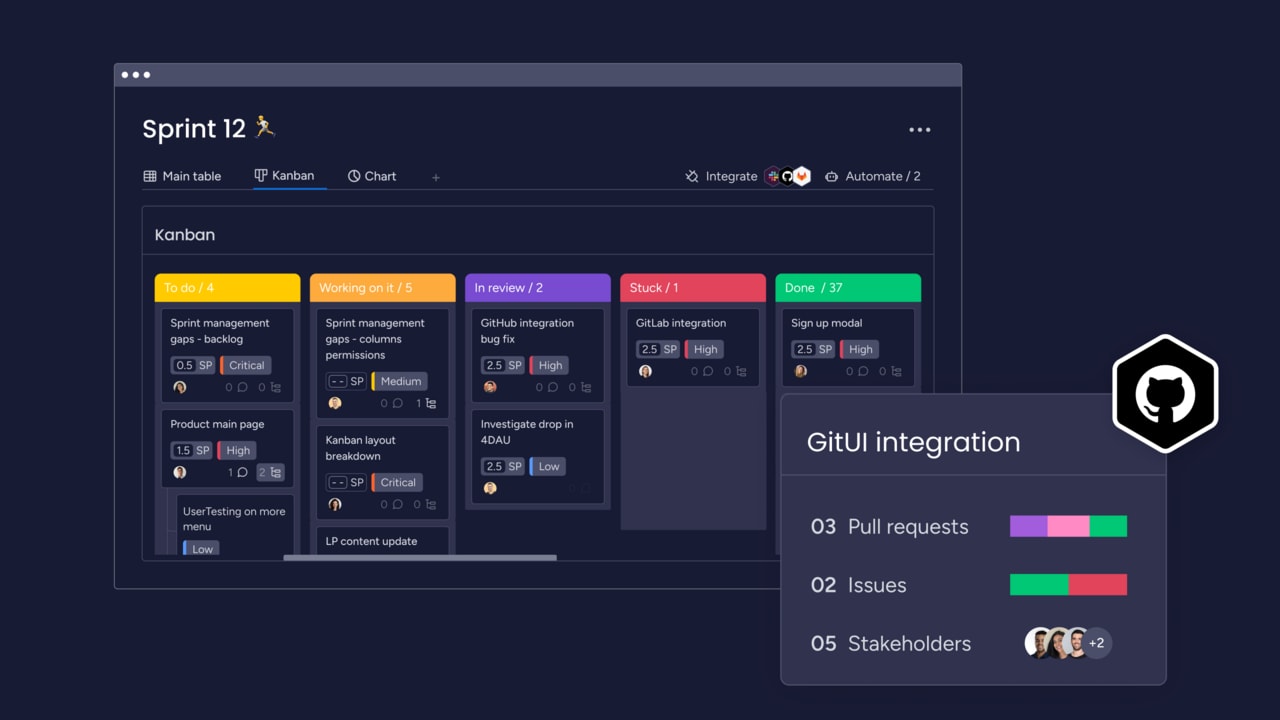
6 essential Kanban practices
Once you understand the principles, these essential practices show you how to apply kanban day to day. They help you visualize work, manage flow, and create a system your team can improve continuously.
1. Visualize your workflow
Creating a visual representation of your work process is the foundation of Kanban. Your board should show every stage work passes through, from initial request to final delivery. Here’s what effective visualization includes:
- Different work types: use colors or labels to distinguish features, bugs, and technical work.
- Current status: make it obvious what’s active, blocked, or waiting.
- Who’s responsible: show assignments clearly so everyone knows who to talk to.
2. Limit work in progress
Setting WIP limits prevents your team from drowning in half-finished work. Start conservatively, aiming for one or two items per person, and adjust based on what you observe. These limits create focus and expose problems quickly.
When you hit a limit, the team must finish something before starting new work. This constraint drives collaboration and problem-solving.
3. Manage flow
Watch how work moves through your system. Track how long items take, where they get stuck, and what causes delays. Platforms like monday dev provide built-in analytics that show these patterns without manual tracking.
Good flow management means work moves steadily without rushing or stalling. You’re looking for sustainable pace, not maximum speed.
4. Make policies explicit
Document your team’s working agreements, specifying when work moves between columns, establishing a clear definition of ‘done’ for each stage, and defining who can pull work from where. Clear policies prevent confusion and enable consistent decisions.
Post these policies where everyone can see them. Digital boards can include them right on the board, keeping rules visible and current.
5. Implement feedback loops
Regular check-ins keep your Kanban system healthy. Daily standups review the board and address blockers. Weekly reviews examine flow metrics and plan improvements. Monthly retrospectives tackle bigger process questions.
These feedback loops should produce action, not just discussion. Each review should identify at least one small improvement to try.
6. Improve collaboratively
Use data to guide improvements. If cycle times are increasing, investigate why. If certain types of work always get stuck, address the root cause. Involve the whole team in identifying and implementing improvements.
Collaborative improvement ensures changes stick because everyone understands and supports them.
Key benefits of Kanban for Agile teams
Kanban gives Agile teams a clearer, calmer way to manage moving work. By visualizing every stage of the process and limiting how much is in progress at once, teams avoid overload and respond to change with confidence. These benefits compound over time, helping teams deliver faster, collaborate more effectively, and make decisions based on real data instead of assumptions.
Enhanced visibility and transparency
Kanban boards put all work in plain sight. Everyone sees priorities, progress, and problems without asking for updates or sitting through status meetings. This transparency builds trust with stakeholders and helps teams coordinate naturally.
Platforms like monday dev enhance this visibility with dashboards that aggregate data from multiple boards. Leaders get the big picture while teams focus on their immediate work.
Increased flexibility
Need to shift priorities? Kanban handles change gracefully. New urgent work enters the flow as capacity allows, without disrupting work already in progress. This flexibility makes Kanban ideal for teams facing unpredictable demands.
You respond to change by adjusting what enters the system, not by constantly reshuffling work in progress.
Reduced bottlenecks
WIP limits expose bottlenecks immediately. When work piles up in one column, everyone sees it and can help resolve the blockage. This visibility transforms bottlenecks from hidden productivity killers into visible problems the team solves together.
Regular attention to flow patterns helps you prevent bottlenecks before they form.
Improved delivery predictability
Historical flow data makes forecasting reliable. Instead of guessing how long work will take, you use actual cycle times to predict delivery dates. This data-driven approach builds credibility with stakeholders.
Teams using solutions like monday dev can track these metrics automatically, turning data collection from a chore into an asset.
Enhanced team collaboration
Kanban’s visual nature and WIP limits naturally encourage collaboration. When someone’s blocked, others help. When WIP limits prevent new work, the team focuses on finishing current items together.
This collaboration happens organically around the board rather than through forced team-building exercises.
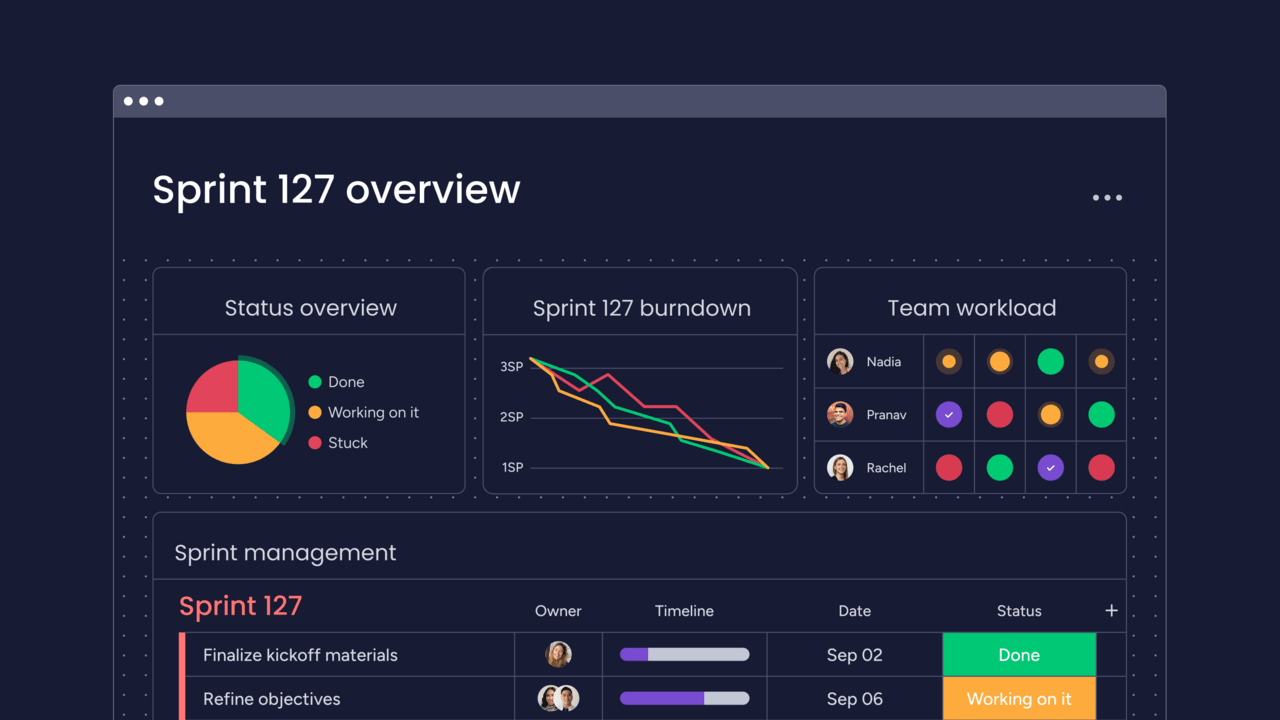
Kanban vs other Agile methodologies
Agile teams often mix and match frameworks, so understanding how kanban differs from other approaches can help you choose the right fit. Each methodology offers its own structure, cadence, and level of flexibility. Comparing them side by side makes it easier to decide when kanban works best and when another framework might serve your team better.
Kanban vs Scrum
Both support Agile principles but take different approaches, forming part of Agile best practices in many organizations. Scrum organizes work into time-boxed sprints with prescribed roles and ceremonies, typically tracked on a Scrum board. Kanban uses continuous flow with no mandatory roles or meetings (Kanban vs Scrum differences).
Choose Scrum when you need structure and predictable delivery cycles (Agile vs Scrum guide). Choose Kanban when you need flexibility and continuous delivery. Many teams even combine elements of both in a ‘Scrumban’ approach.
Kanban vs Waterfall
Waterfall follows sequential phases where each must complete before the next begins. Kanban allows work to flow continuously with frequent delivery and adaptation. Where waterfall assumes you can plan everything upfront, Kanban embraces learning and change, much like rolling wave planning in Agile contexts.
Waterfall follows sequential phases where each must complete before the next begins. Kanban allows work to flow continuously with frequent delivery and adaptation. Where waterfall assumes you can plan everything upfront, Kanban embraces learning and change, and its visual boards provide more transparency than traditional status reports, keeping everyone informed in real-time.
When to combine frameworks
Successful teams recognize that no single methodology fits every context. While some teams weigh Lean vs Scrum differences, many successful teams blend approaches to fit their context. You might use Scrum’s sprint planning with kanban’s WIP limits, a combination often referred to as Scrumban, or apply Kanban to your daily work while using Waterfall for regulatory requirements.
The right platform should support these hybrid approaches, allowing you to easily configure boards and workflows to match your chosen blend of practices.
When to use Kanban methodology
Kanban shines in specific situations. Teams handling support requests, bug fixes, or operational work benefit from its continuous flow approach. You can’t tell customers to wait for the next sprint when production is down.
Marketing teams love Kanban for managing campaigns with shifting priorities. Product teams use it to balance feature development with technical debt, often alongside a kano model template to prioritize features. Any team juggling multiple stakeholders and changing priorities finds value in Kanban’s flexibility.
- Unpredictable workload: support and maintenance teams can’t plan sprints when urgent issues arise daily.
- Continuous delivery: teams shipping features as soon as they’re ready rather than in batches.
- Multiple work streams: groups balancing projects, operations, and ad-hoc requests.
- Cross-functional collaboration: teams that need visibility across department boundaries.
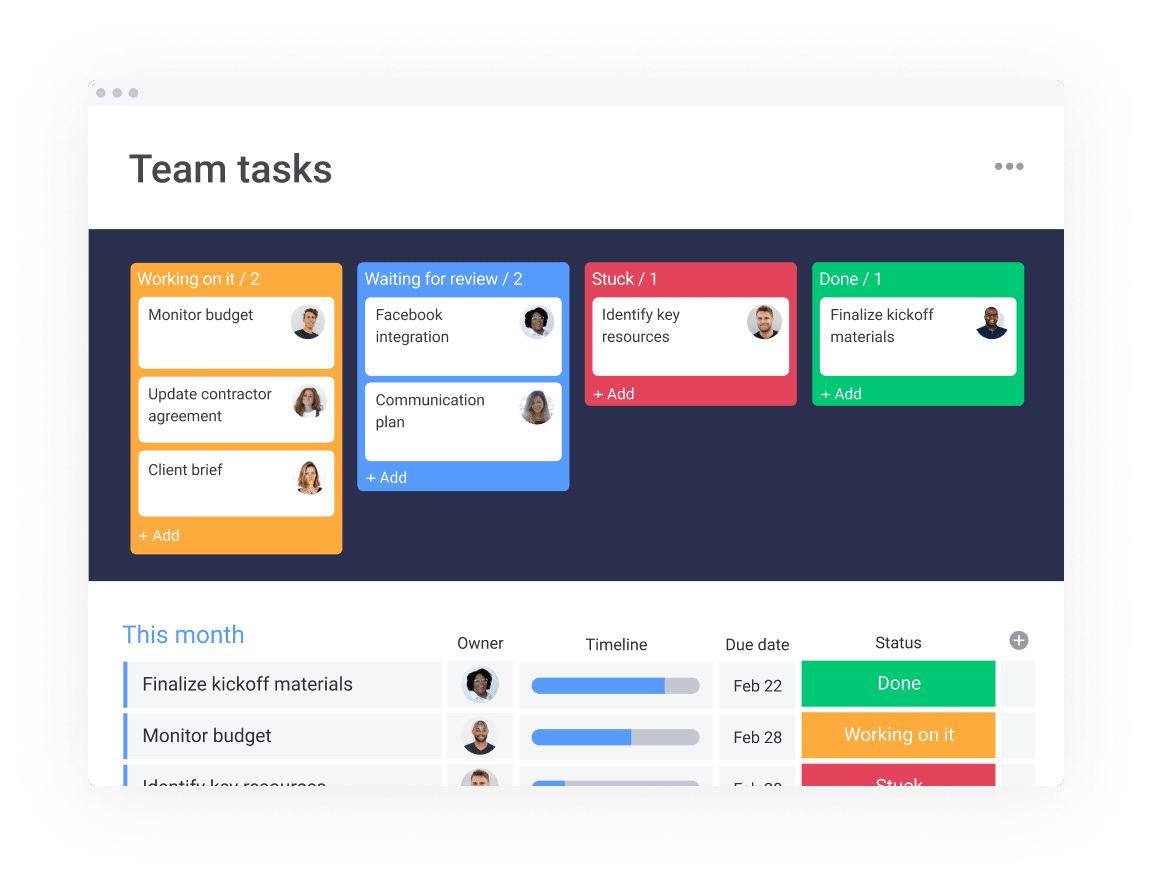
How to implement Kanban in 5 steps
Implementing kanban doesn’t require a major overhaul — you build it around the way your team already works. These five steps give you a simple path to create your first board, set the right limits, and establish a flow your team can improve over time.
Step 1: map your current workflow
Gather your team and map how work really flows today. The objective is not to design an ideal process, but to accurately capture your current reality. Be sure to include every handoff, review, and waiting period. This honest assessment becomes your essential starting point for all future improvements.
Step 2: build your Kanban board
Transform your workflow map into board columns. Each stage in your process becomes a dedicated column where work items will reside. Modern solutions like monday dev offer customizable boards that simplify this step, allowing you to match any workflow. Always start simple; you can always add complexity to your board later.
Step 3: set WIP limits
Begin with conservative limits, perhaps one or two items per person per column. These limits will feel constraining at first. That’s the point. They force focus and reveal where your process needs attention.
Step 4: pull work through the system
Train your team to pull work when they have capacity, not when someone pushes it to them. This shift takes practice. Establish clear criteria for moving work between columns so everyone makes consistent decisions.
Step 5: measure and improve
Track basic metrics, such as cycle time and throughput. Analyze the resulting data to identify patterns and trends in your workflow. Conduct regular reviews to discuss process successes and failures, then commit to making one small improvement at a time and rigorously measure its impact.
Kanban metrics for continuous improvement
Kanban is a data-driven system. Tracking specific metrics is non-negotiable for identifying bottlenecks, setting realistic forecasts, and measuring the impact of your process changes:
- Cycle Time and Lead Time: Cycle Time measures how long work takes once it starts, while Lead Time includes the waiting time before work begins. Together, these metrics reveal your true delivery speed and help set realistic expectations with stakeholders. Modern platforms like monday dev track these metrics automatically, providing you with data without manual effort.
- Throughput: throughput counts how many items your team completes per week or month. This metric is essential for capacity planning and shows whether your process improvements actually increase delivery speed. Always watch for trends in throughput rather than focusing on hitting arbitrary targets.
- Work item age: age tracking shows how long each item has been in progress. Any item aging beyond normal cycle times requires immediate attention before it becomes a major blocker, making regular age reviews critical to prevent work from stalling indefinitely.
- Flow efficiency: flow efficiency compares the active work time to the total cycle time. A low efficiency score reveals that too much time is spent waiting between work stages, clearly guiding your process improvements to where they are needed most.
Digital Kanban platforms for development teams
Modern development teams need more than a visual board. They need integration with development tools, automation for routine tasks, and analytics for continuous improvement. The right platform amplifies Kanban’s benefits rather than just digitizing a physical board.
Look for platforms that connect with your existing Kanban tools. When code commits automatically update cards, or bug reports create new work items, you maintain accurate boards without manual overhead. monday dev excels here with extensive integration options.
Automation should handle the repetitive stuff. Moving cards based on status changes, notifying team members when work is ready, creating recurring tasks — these automations keep your board current while your team focuses on valuable work.
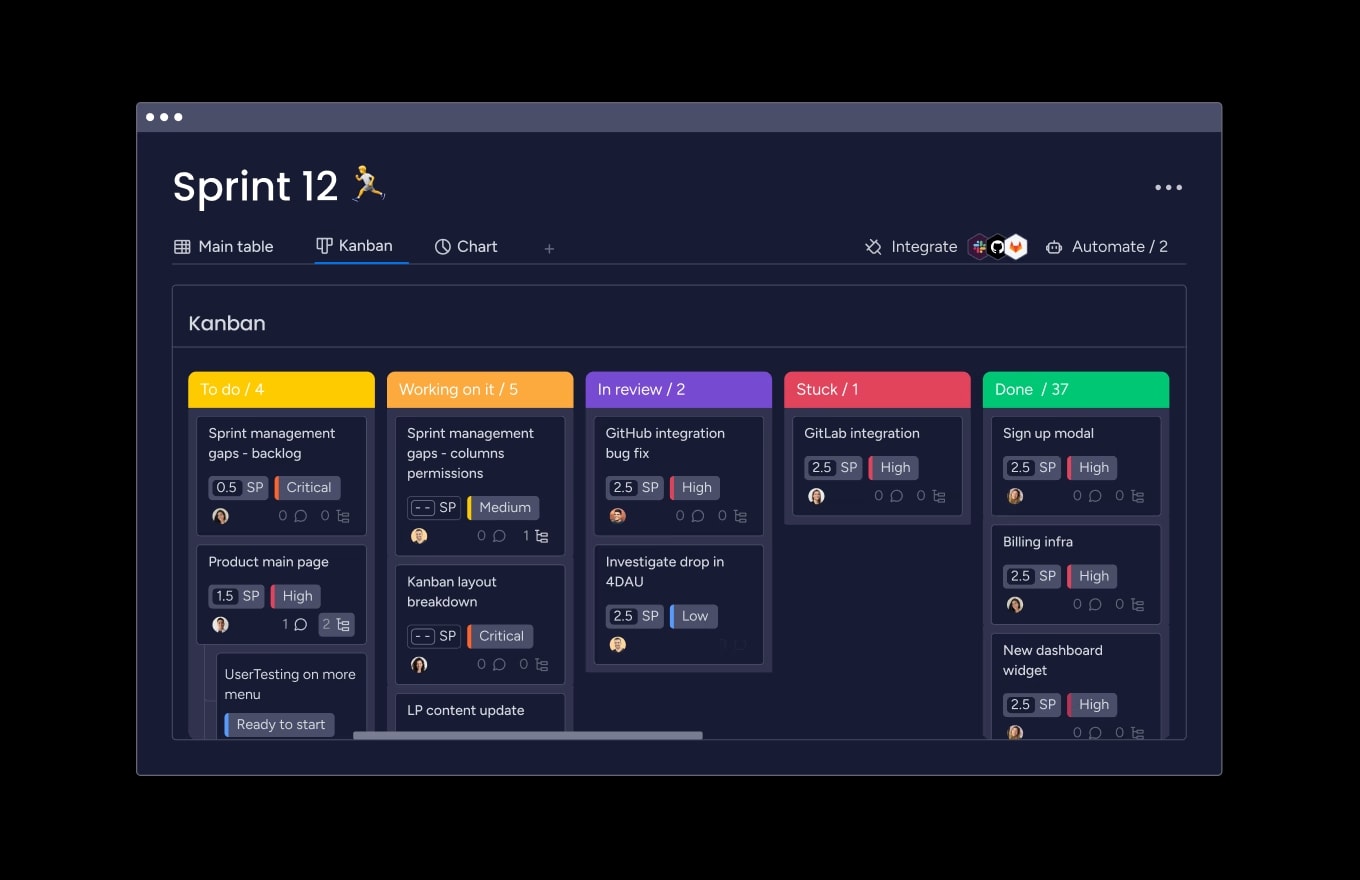
Power your Kanban workflow with monday dev
A strong kanban system becomes even more effective when the platform behind it supports automation, real-time updates, and connected development work. With monday dev, teams can keep their boards accurate, streamline handoffs, and track performance through built-in analytics — all while maintaining a steady, predictable flow.
Visual boards designed for developers
Flexible platforms like monday dev provide Kanban boards built specifically for development teams. Customize columns to match your exact workflow, whether you’re managing features, bugs, or technical debt. Integration with Git platforms keeps your board synchronized with actual development progress.
Consider the synchronization of a Git repository. When connected, actions like opening a pull request automatically move cards into the “Code Review” column. When a developer merges code to the main branch, the card instantly progresses to “Testing” without requiring manual intervention. This level of integration ensures the Kanban board always reflects the actual state of development, eliminating reliance on human memory for status updates.
The visual design makes complex technical work accessible to all stakeholders. Product managers, designers, and executives can understand project status without technical expertise.
Automated workflows at scale
Automation is essential for maintaining Kanban flow without administrative burden. By setting up rules to handle routine tasks, you free your team to focus on development:
- Continuous flow maintenance: automations maintain your Kanban board without manual updates. Cards move automatically when developers push code or when reviews are completed, ensuring the board always reflects the true status of the work.
- Intelligent coordination: the system should handle routine coordination, such as notifying the right people when work is ready for their stage or creating recurring tasks. These automations scale easily with your team’s size and workload.
- Customized process enforcement: you can build custom automation recipes to enforce your specific policies. This includes routing critical work to the top of the queue or automatically assigning tasks to available team members based on their current Work In Progress (WIP) count.
Real-time analytics and insights
Built-in dashboards track all your Kanban metrics automatically. See cycle times, throughput, and bottlenecks in real-time. Historical data helps you spot trends and measure the impact of process improvements.
Open your sprint dashboard and immediately see that your average cycle time jumped from four days to seven days this week. Drill down and discover that code reviews are taking longer because two senior developers are on vacation. Or use the throughput widget to show stakeholders that your team completed 23 items last month compared to 18 the month before. Concrete proof that your process improvements are working.
These insights guide better decisions about capacity, priorities, and process changes. You move from guessing to knowing how your team really performs.
Frequently asked questions
Can Kanban methodology work for non-software teams?
Yes, kanban works well beyond software. Any team that manages work through a series of steps can benefit from it. Marketing teams use kanban to track campaigns, HR teams follow candidates through hiring stages, and operations teams rely on it to manage service requests. The core ideas — visualizing work, limiting what’s in progress, and improving flow — apply to almost any process with repeatable stages.
How long does Kanban implementation typically take?
Kanban implementation can begin immediately since you start with existing processes. Most teams see initial improvements within the first week of visualizing work and setting WIP limits. Deeper benefits like improved flow and reduced cycle times typically emerge after two to four weeks of consistent practice.
Can Kanban methodology work effectively for remote teams?
Kanban methodology works exceptionally well for remote teams. In fact, research from MIT's Center for Collective Intelligence (as reported by the World Economic Forum in 2021) shows that a group's collective intelligence was just as high in a virtual setting as when working face-to-face. Digital Kanban boards provide the shared visibility and asynchronous collaboration that remote teams need to achieve this. The visual board becomes a central communication hub, reducing the need for status meetings while keeping everyone aligned.
What is the ideal WIP limit for Kanban boards?
The ideal WIP limit typically equals the number of team members or slightly fewer. Start conservatively and adjust based on actual flow patterns. Good limits prevent multitasking while avoiding idle time. Most teams find their optimal limits through experimentation over several weeks.
How do you handle urgent requests in Kanban methodology?
Urgent requests in Kanban can use expedite lanes or special handling rules. Define clear criteria for what qualifies as urgent and track how often you use expedite options. This prevents everything becoming urgent while ensuring critical work gets priority when truly needed.
Can Kanban methodology scale across multiple development teams?
Kanban methodology scales effectively through portfolio boards and connected workflows. Large organizations use hierarchical Kanban systems where team boards feed into program boards, which connect to portfolio views, aligning well with lean portfolio management principles. Platforms like monday dev provide the integration and visibility needed for this multi-level approach.
 Get started
Get started 


